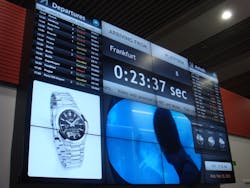Airports are consistently busy places, and some are starting to double as shopping malls or high-end food courts in an effort to improve what sometimes can be a frustrating experience for passengers: Long lines at security, flight delays due to weather and lost baggage are all challenges passengers may experience when flying the friendly skies.
As airports morph from transit hubs into places to shop, dine and relax before a flight, they can pair these offerings with a digital signage platform to amplify customer engagement.
Chances are that most air travelers already have come across some form of digital signage. Anyone who has used a screen to check flight departure times has viewed real-time information via airport digital signage. And digital signage deployment in airports is poised to take off: The compound annual growth rate of digital signage in transportation, including airports, is expected to increase 18.9 percent from 2014 to 2020.
But digital signage isn’t just about arrival and departure information anymore. There are a number of other reasons for airports to invest in digital signage.
Why Use Digital Signage
In the past, static signage was used as wayfinding across all types of transportation. The changeable nature of modern transportation methods, however, means that static wayfinding signage can be quite useless. Airports, especially, exist in a highly dynamic world; thus, it makes sense they are moving away from static signage and going digital.
Digital signage is easily updated and offers interactive experiences. Digital displays give the flexibility and fluidity an airport requires by making it easy to instantly swap out content by uploading it to a server – whereas a static sign can only be updated if an employee physically changes out the sign.
Because it is so much easier to update instantly, digital signage can integrate real-time data. Its functionalities allow on-the-spot updates of news, weather, emergency alerts and delays, as well as location-based advertising.
Digital signage is almost omnipresent at airport counters, boarding areas and baggage claim – all informational settings – but the new ways in which it is being used are helping to enhance customer engagement.
Until passengers are past security, digital signage is better used for information and wayfinding – people want to know where to drop their bags and then how to get through the security lines as quickly as possible. After security, however, digital signage can be geared toward entertainment – content that may be viewed while waiting for a flight or in line at a store or for restaurant seating. Informational signage regarding flight updates, locations and gate changes still are important, but many people have time to linger in airports and want to be entertained externally, not just via their smartphones.
Ads make sense in airports, too. According to ScreenMedia Daily, “Key growth drivers for digital out-of-home advertising included customers spending more time with media outside their homes; increased engagement with digital out-of-home screen content linked to mobile devices; increased exposure to the medium on public transportation combined with longer commuting time; and the growth in both leisure travel and longer shopping hours.” All of these factors play a role in why airports should use digital signage for advertising and engagement while passengers shop, dine and wait for flights.
Digital signage systems’ naturally dynamic capabilities are able to showcase advertising that is meaningful to the intended audience. Its features allow the ability to incorporate a brand’s colors and logo, showcase compelling visuals, and interact with user technologies like mobile phones, which ultimately increases user engagement and can lead to an increase in sales.
Four Ways to Measure and Boost Engagement
There are four key best practices for an airport looking to expand the customer experience:
1 – Advertise items of interest. Especially after customers cross into the post-security realm of the airport, they’re looking for ways to be entertained while they wait to board their flights.
Their options might include buying memorabilia associated with the city they’re in from airport stores; trying airport restaurants with celebrity chefs’ names attached to them; cashing in on deals at airport stores or restaurants; or picking up special duty-free items available within the airport.
Using digital signage to advertise these potential purchases is more effective than using static signage; a Rich Media Technologies study indicates that digital signage is 63 percent more attention grabbing than static signs. Running ads for the purchases that a captive audience can make right inside the airport will help increase customer spending.
2 – Enable touch. Many airports already use touchscreen kiosks at check in, but they can also be deployed post-security. Kiosk touchscreens help create an interactive experience for customers, allowing users to browse offerings in the area or search for a specific outlet, and obtain directions on the fly. Many also are utilizing analytics to better understand the users and their interests to help drive new, effective content and advertising.
3 – Be able to measure engagement levels. A good way to do this is by using a call to action that asks customers to text a certain number to receive a digital coupon, or provide their mobile numbers or email address to receive updates or offers. This will help measure how many people are engaging with the content on a display. Airports may even want to do an A-B test by testing out two different pieces of content advertising the same thing and see which one is engaging more with customers, and then use the more effective one to increase awareness.
Some displays are often coupled with a software element that can measure engagement levels using facial recognition, which can not only determine dwell time, but also can target advertising by determining age range and gender of the consumer.
4 – Employ technology. Beacons, near-field communication (NFC) or RFID chips can be added to kiosks or digital displays to create new levels of interactivity and engagement. A user can tap a smartphone to a display or kiosk with NFC technology, or use a QR code to receive flight or product information directly to a device.
Beacons are a fast-growing technology in many sectors; Business Insider estimates that there will be 4.5 million active beacons by the end of 2018. There are many apps for air travel, and beacons can pick up that a traveler’s mobile phone has the app and target market them on digital displays, or beam ads or promotions directly to a smart device (the caveat here is that a traveler must opt in to receive these).
Five Best Practices and Considerations
These five best practices will help guide an airport looking to invest in digital signage:
- Budget: Budget is an important consideration for any purchase and should be addressed early in the project, so an integrator can help an airport choose the best possible solution for its needs. Commercial-grade displays will always have a higher price point than a big-box store TV, but there are many reasons why that investment is worthwhile.
The image quality of a commercial display will not only be brighter, clearer, and less reflective than traditional televisions, but the panels also are also built to withstand longer operating hours, so the 24/7 runtimes that airports require can be achieved without worry. On top of this, features such as a full metal chassis, integrated active cooling system and real-time temperature sensors protect the investment in the screen.
- Control options: A majority of commercial display products can be networked so that all control of the content, scheduling and asset management can be done from a control room behind the scenes. A majority of display systems also can automatically send email alerts to a network administrator if there is risk of overheating or any type of change to the system.
Another benefit of having network-based control is the ability to switch an input or push content on demand – meaning if there is an emergency, content can be changed in an instant to push emergency messaging.
- Traffic patterns: By conducting a traffic pattern study, an airport will be able to understand where people are walking and where they are looking. This can help to position the displays in the right location for both wayfinding and advertising purposes. Adding biometric capabilities can determine viewer aspects such as gender and age, so that messaging can be targeted based on the demographics that comprise the majority of traffic flow.
- Content: From an engagement standpoint, it is strongly recommended that content is rotated and changed out frequently. People tend to look past things that they see constantly, but if content is always fresh, it will draw the eye. When rotating content, keep each image/slide on the display long enough for it to be read and digested, but not long enough that viewers become bored.
- Environment: To guide the airport to the right technology, whatever manufacturer or integrator an airport selects should be made aware of all environmental conditions in the space. Conditions like ambient light change throughout the year and can wash out certain types of displays, so any large glass ceilings or walls should be considered when determining display placement.
Ambient light also affects screen brightness: A display inside an atrium may require higher brightness capabilities to counteract the ambient light from skylights, for example. A feature like automatic dimming, through an ambient light sensor, may be necessary if the display’s brightness has to be adjusted to go from bright conditions to darker conditions throughout the course of the day.
Types of Digital Displays: LED versus LCD
Both liquid crystal displays (LCD) and light-emitting diode (LED) displays have uses within different applications in an airport.
LCD technology allows higher-resolution capabilities at closer viewing distances; however, it is important to choose a robust display. For up-close viewing, wayfinding and entertainment, LCDs work well.
A specification that is often overlooked, but is extremely important in airports, is something called “haze.” LCDs with high-haze panels have a matte finish on the front of the panel, which allows ambient light to be scattered more so than reflected – an important feature in an airport, where ambient light is often in abundance. If an LCD panel cannot scatter the incident light that hits the display panel, an image may be washed out or unreadable
LCDs typically work best for displaying flight information, gate information, baggage information, advertising or wayfinding (when touch interactivity is added to the displays). Their content is generally informational in nature. They can be used both when travelers first enter an airport and are looking for an airline’s check-in desk, and after security, to either display flight information or act as televisions for entertainment purposes.
LEDs are light-emitting diodes, meaning they emit colors and are not reflective the way an LCD is. Even though they do not reflect light the same way an LCD does, it’s still important to consider the reflectivity of an LED panel’s surface, and the two factors that affect it.
The first is resin placed over the LED itself. Most quality LED displays developed for indoor applications will use a small LED package that houses the red, blue and green LEDs in a single packet, which is covered with a resin to protect the LEDs. The face of these packetized LEDs can either be white or varying shades of gray, and the darker the face, the less light it will typically reflect.
The second factor is the reflective properties of the mask or area between the LEDs, which is typically made from black plastic with a matte surface. One good way to tell if the mask has adequate antireflective properties is to view the display from the side. If the display turns into a mirror, it may not have adequate antireflective properties.
LED displays work well for any kind of distance viewing, including advertising, or if content warrants a large, seamless display. LED displays can be produced with fine pixel pitches to give the displays high clarity and picture quality up close. They can also be produced with a wider pixel pitch and very bright intensity, allowing viewing at great distances, even in outdoor spaces. This means that airports have greater flexibility with the type of content they choose to display (including font type and size), as well as where the displays are placed – travelers will be able to read them whether they are close or far away.
Five Steps to Implementing Digital Signage
When an airport is looking to implement digital signage into its terminals and at gates, there are five steps to developing a plan.
The first is to determine what the goals are. These could be simply to get travelers from point to point, or they could be more involved: increase awareness of the facility’s offerings, attempt to boost sales through advertising, add interactivity, etc.
Once goals are defined, the next step is to understand the project’s budget. Digital signage technologies and systems vary greatly in cost, and having a predetermined budget will help guide an airport to the correct technologies based on its individual financial plan.
The next step is determining what type of display technology will best achieve the goals while staying within the budget. For this task, it may be helpful to employ a digital signage consultant or speak directly with a supplier that has capabilities in both types of display technologies.
After that, it’s important to determine how the airport expects to benefit from what it deploys – how to measure engagement based on the costs associated with the investment in digital signage. As mentioned above, a digital signage consultant or a qualified display manufacturer can offer technologies or techniques to measure the audience engagement of digital signage.
Lastly, it’s important to think about the future: what additional resources or add-ons can be integrated into a digital signage strategy. Advertising is the most obvious add-on. In airports, it’s often seen as less disruptive than in the home. Travelers expect to see ads within a terminal, viewing them as more helpful and timely than in-home advertising by showing travelers where to eat or shop within a terminal, as well as local attractions and services like Wi-Fi.
Using digital signage to engage and interact with travelers creates a smoother traveling experience for customers while boosting revenue for the airport, and is part of the next wave of air travel. The airport of the future is ready to take off.
Ben Hardy is product manager for NEC Display Solutions. Hardy can be reached at [email protected]. Grant Wylie is the senior product manager for LED at NEC Display Solutions. Wylie can be reached at [email protected].








